Overview
- Brief Narrative
- Scrip, valued at 5 [funf] kronen, issued in Theresienstadt (Terezin) ghetto-labor camp after January 1, 1943. All currency was confiscated upon entry and replaced with scrip and ration coupons that could be exchanged only in the camp. The camp existed from November 24, 1941 to May 9, 1945, in a region of Czechoslovakia annexed by Germany, renamed the Protectorate of Bohemia and Moravia. Rose acquired the scrip from her brother-in-law Dr. Henri Brunswic, who lived in Paris, France. In November 1940, a year after the German occupation of Poland in September 1939, Raszka (Rose Galek), her parents Moshe and Fela, and her younger sisters Deana and Sala were confined to the Warsaw ghetto. In April 1943, Raszka’s parents were shot as she watched and her sisters deported to a concentration camp and presumed killed. Raszka escaped and went into hiding. A resistance member, Jan Majewski, helped her obtain false papers as a Polish Catholic, Maria Kowalczyk. In June, she was sent as a forced laborer to a farm in Krummhardt, Germany. Raszka was liberated by US forces in April 1945. She moved to Stuttgart displaced persons camp and emigrated to the United States in 1947.
- Date
-
issue:
after 1943 January 01
- Geography
-
issue:
Theresienstadt (Concentration camp);
Terezin (Ustecky kraj, Czech Republic)
- Credit Line
- United States Holocaust Memorial Museum Collection, Gift of Rose Galek Brunswic on behalf of Etienne Brunswic
- Markings
- face, upper center, brown ink : QUITTUNG ÜBER / FÜNF KRONEN [RECEIPT OF / FIVE CROWNS]
face, lower center, brown ink : 5
front, lower center, brown ink : WER DIESE QUITTUNG VERFÄLSCHT ODER NACHMACHT / ODER GEFÄLSCHTE QUITTUNGEN IN VERKEHR BRINGT. / WIRD STRENGSTENS BESTRAFT [ANYONE WHO FALSIFIES OR DISTORTS OR FAKES THIS RECEIPT, OR COUNTERFEITS RECEIPT, WILL BE STRICTLY PUNISHED]
reverse, upper left, plate letter and number, brown ink : A022
reverse, center, brown ink : Quittung / über / FÜNF KRONEN [Receipt / of / FIVE CROWNS]
reverse, lower center, brown ink : THERESIENSTADT, AM 1.JANNER 1943 DER ALTESTE DER JUDEN / IN THERESIENSTADT [THERESIENSTADT, ON 1. JANUARY 1943 THE ELDER OF THE JEWS IN THERESIENSTADT]
reverse, bottom right, printed in brown ink : Jakob Edelstein - Contributor
-
Subject:
Rose G. Brunswic
Designer: Peter Kien
Printer: National Bank of Prague
Issuer: Der Alteste der Juden in Theresienstadt
- Biography
-
Raszka Galek was born on November 24, 1920, in Sochocin, Poland, to Moshe and Fela (Zipora) Perznianko Galek. She had three sisters: Hinda, Deana (Dina), and Sala (Sara). Her father Moshe was born December 19, 1883, in Sochocin, to Yaakov and Zelda Mottel Galek. He had three sisters and three brothers. Moshe owned a mother of pearl button factory with 100 employees. Raszka’s mother Fela was born May 12, 1892, in Zakroczym, to Yehoshua, a lawyer, and Basha Perznianko. She had one brother, Tolek, who went to Russia before World War I. Fela was a hat designer in Warsaw until she married Moshe. The family was prosperous and employed several maids and a nanny. They lived with Raszka’s paternal grandmother, who ran a general store and bakery. Around 1930, Raszka’s maternal grandmother Basha moved in with them after her husband died. Raszka and her sisters attended a Polish school, where she learned German and English. She studied Hebrew twice a week. Circa 1934, the family moved to Warsaw so the children could receive a better education. Raszka’s sister Hinda married in 1938 and left for Palestine in early 1939. Made anxious by the rising antisemitism, Moshe wanted to use bribery to get to Italy and then Palestine. Fela did not want to start over, so Moshe decided they would stay.
On September 1, 1939, Germany invaded Poland. Warsaw was heavily bombed and German troops occupied the city on September 29. Moshe evenly divided the family’s possessions, such as jewelry and American gold coins, and said that they should all save themselves. In December, the family was required to wear Star of David armbands. In November 1940, the Galek family had to move into the newly formed Jewish ghetto, to an apartment crowded with many other families. There was very little food and no electricity or heat. Raszka briefly worked with the Judenrat in food distribution. In April 1943, the Germans lined up the Jews for a selection. Moshe and Fela, emaciated and weak, were shot in front of their children. Raszka and her sisters were lined up with younger people. Raszka escaped and hid in an alleyway where she was found by the underground. She was provided with false papers as a Catholic named Maria Jadwiga Kowalczyk and she then escaped to the Aryan section of Warsaw through the sewers. She went to the home of a former employee of her father, Mr. Nawrocki, who hid her in his attic in exchange for gold and jewelry. Raszka saw the ghetto burning during the Warsaw Ghetto Uprising. In May, she developed whooping cough and was asked to leave. She walked aimlessly and was stopped and questioned by an SS officer. He realized she was Jewish but she bribed him with her last gold coin and he let her go. She went to the Vistula River and contemplated suicide. She was approached by Jan Majewski, a Polish Catholic who ran a refugee camp for Polish citizens expelled from Germany. He examined her false papers and saw that she was from his hometown. Jan knew there was no one named Kowalczyk in the village and realized Raszka was Jewish. He agreed to let her stay at the camp. After about a month, the Germans began to suspect Jews were hidden in the camp. Realizing it was no longer safe, Jan took Raszka to a church where several Polish people were hiding.
In June 1943, the church was raided by the Germans. Raszka was sent to Germany as a Polish forced laborer. Because she spoke German, she was selected leader of her group. Upon arrival in Berlin, she was allowed to choose her workplace. Her options were an ammunitions factory, a hotel, or a farm. She wanted to avoid other Polish people in case they recognized her and decided that a farm was the safest choice. She was sent to the farm of Ernst Scharpf in Krummhardt, a small village near Esslingen. Ernst’s daughter Luise ran the farm with her husband Karl Beck, who was in the SS. Ernst was paralyzed, Karl worked at an ammunitions factory in Esslingen, and Luise spent her days caring for her child, so Raszka did the majority of the farm work. She chopped wood, cared for the animals, and ran errands. Luise and Ernst were kind to her. Raszka was afraid that Karl would take advantage of her because he made inappropriate comments about her, but she was never harmed. To maintain her false identity, Raszka regularly attended Catholic Church services. Several other Polish forced laborers attended the church, so Raszka decided it was too risky to go. She converted to Lutheranism and attended services with Ernst’s family. Raszka was required to wear a Polish forced laborer badge at all times. She once was caught without it on a trip to Esslingen and was severely beaten by a police officer. In September 1944, she forgot to wear it a second time and was taken to court and fined. The judge was sympathetic and made her a Polish interpreter for the court.
As American troops approached in April 1945, Karl asked Raszka to burn his SS uniform so the Americans would not discover it. After she was liberated, Raszka stayed at the farm for two weeks to be sure that the Americans would not retreat. She then went to Stuttgart displaced persons camp. She worked as liaison between displaced persons camps and the United Nations Relief and Rehabilitation Association (UNRRA). She met Kurt Braunschweig (1920-1999), an UNRRA employee from Heidelberg. Kurt and his family had fled Germany for the Netherlands after the Nazi regime took power. They later went to France where Kurt served in the French army and then was held as a German prisoner of war from 1940 until 1945. Raszka and Kurt married on May 11, 1946. A US soldier helped locate Raszka’s paternal uncle, Irving Galek, who sent them affidavits for US visas. Raszka was six months pregnant and no ship would take her. Kurt’s father Willy arranged for them to be flown to New York on American Army plane on January 7, 1947. Their daughter was born that March. They settled in New York and changed their names to Claude and Rose Brunswic. Rose worked as a housekeeper, a seamstress, and a bookkeeper. During a 1987 visit to Poland, she learned that her sisters were killed in Auschwitz. She also met a man whose mother had worked in her father's factory and he gave her buttons she had saved from there. In 1993, Rose, 73, received a fine arts degree. She had never been able to speak about her wartime experiences, but through her artwork, she broke her silence. She began speaking often to numerous groups, believing that "We have the responsibility to those who have perished to remember the voices that were silenced." Claude, 79, passed away in 1999. Rose, age 92, died on February 22, 2013, in Virginia.
Franz Peter Kien was born January 1, 1919, in Varnsdorf, Czechoslovakia (Czech Republic), to Leonard and Olga Frankl Kien. His father Leonard was born in 1886, in Varnsdorf, and was a member of the German-speaking Jewish population in the, the Sudetenalnd, which bordered Germany. Leonard was a textile manufacturer with his own factory. Peter’s mother Olga was born in 1898, in Bzenec, Austro-Hungary (Czech Republic), to Jewish parents. After 1929, the Kien family moved to Brno. Peter enrolled at the German Gymnasium, where he excelled at drawing, painting, and writing. In 1936, he graduated and moved to Prague to study at the Academy of Fine Arts. He also attended the Officina Pragensis, a private graphic design school run by a well-known Jewish artist, Hugo Steiner-Prag.
On September 29, 1938, Germany annexed the Sudetenland. On March 15, 1939, Germany invaded Prague and annexed the Bohemia and Moravia provinces of Czechoslovakia, ruled by a Reich Protector. Jews were banned from participation in government, businesses, and organization, including schools. Peter had to leave the Academy, but continued to study at the Officina Pragensis. He also taught at Vinohrady Synagogue. In September 1940, Peter married Ilse Stranska, who was born on May 9, 1915, in Pilsen, to Jewish parents.
In late September 1941, Reinhard Heydrich, the SS head of RSHA, Reich Main Security Office, became Reich Protector. Soon there were regular deportations of Jews to concentration camps. At the end of November, Theresienstadt concentration and transit camp near Prague got its first shipment of Jewish prisoners. On December 14, Peter was transported to Theresienstadt ghetto-labor camp. He was assigned to the technical department where he worked as a draftsman and designer alongside other artists, including Bedrich Fritta, Leo Haas, and Jiri Lauscher. On July 16, 1942, Peter’s wife Ilse arrived in the camp. On January 30, 1943, Peter’s parents Leonard and Olga were transported from Bzenec to Terezin. Peter was assigned major projects by the Jewish Council that administered the camp for the Germans, such as the scrip receipts used in place of money in the camp. He secretly documented the inmate’s daily life, creating portraits and other drawings, and wrote plays, poems, and an operatic libretto. On October 16, 1944, Peter’s wife Ilse and his parents Leonard and Olga were selected for deportation. Peter volunteered to go with them. Before leaving, Peter and his family were sent to Auschwitz concentration camp in German-occupied Poland. Peter survived the selection process, soon fell ill, likely with typhus, and died at age 25 in late October 1944. His wife and parents were killed at Auschwitz. Some of the work that Peter left with other prisoners or hid at Theresienstadt survived and has been exhibited worldwide.
Physical Details
- Language
- German
- Classification
-
Exchange Media
- Category
-
Money
- Object Type
-
Scrip (aat)
- Genre/Form
- Money
- Physical Description
- Rectangular paper Theresienstadt scrip, 5 kronen, printed in brown ink with a central orange streak. The face has a background of interlocked ovals. On the left is a depiction of a bearded Moses holding 2 tablets with the 10 Commandments in Hebrew characters within a medallion, with German text to the right. The right side has a wide, offwhite border with the denomination 5 in the lower corner and a 6-pointed Star of David above. The reverse has a background of interlocked squares with German text within a large scrollwork line and an engraved signature below. The denomination 5 is in the upper right corner. The left side has a wide, of-white border with the denomination 5 in the lower corner with a 6-pointed Star of David above. The plate letter and number are in the upper left corner. The note is creased with little wear.
- Dimensions
- overall: Height: 2.375 inches (6.033 cm) | Width: 4.625 inches (11.748 cm)
- Materials
- overall : paper, ink
Rights & Restrictions
- Conditions on Access
- No restrictions on access
- Conditions on Use
- No restrictions on use
Keywords & Subjects
Administrative Notes
- Legal Status
- Permanent Collection
- Provenance
- The Theresienstadt scrip was donated to the United States Holocaust Memorial Museum in 1992 by Rose Galek Brunswic.
- Funding Note
- The cataloging of this artifact has been supported by a grant from the Conference on Jewish Material Claims Against Germany.
- Record last modified:
- 2023-06-06 12:37:18
- This page:
- https://collections.ushmm.org/search/catalog/irn7041
Download & Licensing
In-Person Research
- By Appointment
- Request 21 Days in Advance of Visit
- Plan a Research Visit
- Request to See This Object
Contact Us
Also in Rose Galek Brunswic collection
The collection consists of six pieces of Theresienstadt ghetto scrip relating to the experiences of Rose Galek, originally from Poland, who was a forced laborer for Germany during the Holocaust.
Date: 1943
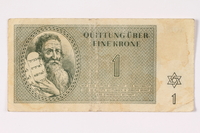
Theresienstadt ghetto-labor camp scrip, 1 krone note
Object
Scrip, valued at 1 krone, issued in Theresienstadt (Terezin) ghetto-labor camp after January 1, 1943. All currency was confiscated upon entry and replaced with scrip and ration coupons that could be exchanged only in the camp. The camp existed from November 24, 1941 to May 9, 1945, in a region of Czechoslovakia annexed by Germany, renamed the Protectorate of Bohemia and Moravia. Rose acquired the scrip from her brother-in-law Dr. Henri Brunswic, who lived in Paris, France. In November 1940, a year after the German occupation of Poland in September 1939, Raszka (Rose) Galek, her parents Moshe and Fela, and her younger sisters Deana and Sala were confined to the Warsaw ghetto. In April 1943, Raszka’s parents were shot as she watched and her sisters deported to a concentration camp and presumed killed. Raszka escaped and went into hiding. A resistance member, Jan Majewski, helped her obtain false papers as a Polish Catholic, Maria Kowalczyk. In June, she was sent as a forced laborer to a farm in Krummhardt, Germany. Raszka was liberated by US forces in April 1945. She moved to Stuttgart displaced persons camp and emigrated to the United States in 1947.
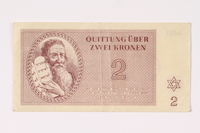
Theresienstadt ghetto-labor camp scrip, 2 kronen note
Object
Scrip, valued at 2 [zwei] kronen, issued in Theresienstadt (Terezin) ghetto-labor camp after 1943. All currency was confiscated upon entry and replaced with scrip and ration coupons that could be exchanged only in the camp. The camp existed from November 24, 1941 to May 9, 1945, in a region of Czechoslovakia annexed by Germany, renamed the Protectorate of Bohemia and Moravia. Rose acquired the scrip from her brother-in-law Dr. Henri Brunswic, who lived in Paris, France. In November 1940, a year after the German occupation of Poland in September 1939, Raszka (Rose) Galek, her parents Moshe and Fela, and her younger sisters Deana and Sala were confined to the Warsaw ghetto. In April 1943, Raszka’s parents were shot as she watched and her sisters deported to a concentration camp and presumed killed. Raszka escaped and went into hiding. A resistance member, Jan Majewski, helped her obtain false papers as a Polish Catholic, Maria Kowalczyk. In June, she was sent as a forced laborer to a farm in Krummhardt, Germany. Raszka was liberated by US forces in April 1945. She moved to Stuttgart displaced persons camp and emigrated to the United States in 1947.
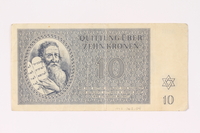
Theresienstadt ghetto-labor camp scrip, 10 kronen note
Object
Scrip, valued at 10 [zehn] kronen, issued in Theresienstadt (Terezin) ghetto-labor camp after January 1, 1943. All currency was confiscated upon entry and replaced with scrip and ration coupons that could be exchanged only in the camp. The camp existed from November 24, 1941 to May 9, 1945, in a region of Czechoslovakia annexed by Germany, renamed the Protectorate of Bohemia and Moravia. Rose acquired the scrip from her brother-in-law Dr. Henri Brunswic, who lived in Paris, France. In November 1940, a year after the German occupation of Poland in September 1939, Raszka (Rose) Galek, her parents Moshe and Fela, and her younger sisters Deana and Sala were confined to the Warsaw ghetto. In April 1943, Raszka’s parents were shot as she watched and her sisters deported to a concentration camp and presumed killed. Raszka escaped and went into hiding. A resistance member, Jan Majewski, helped her obtain false papers as a Polish Catholic, Maria Kowalczyk. In June, she was sent as a forced laborer to a farm in Krummhardt, Germany. Raszka was liberated by US forces in April 1945. She moved to Stuttgart displaced persons camp and emigrated to the United States in 1947.
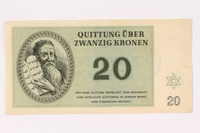
Theresienstadt ghetto-labor camp scrip, 20 kronen note
Object
Scrip, valued at 20 [zwanzig] kronen, issued in Theresienstadt (Terezin) ghetto-labor camp after January 1, 1943. All currency was confiscated upon entry and replaced with scrip and ration coupons that could be exchanged only in the camp. The camp existed from November 24, 1941 to May 9, 1945, in a region of Czechoslovakia annexed by Germany, renamed the Protectorate of Bohemia and Moravia. Rose acquired the scrip from her brother-in-law Dr. Henri Brunswic, who lived in Paris, France. In November 1940, a year after the German occupation of Poland in September 1939, Raszka (Rose) Galek, her parents Moshe and Fela, and her younger sisters Deana and Sala were confined to the Warsaw ghetto. In April 1943, Raszka’s parents were shot as she watched and her sisters deported to a concentration camp and presumed killed. Raszka escaped and went into hiding. A resistance member, Jan Majewski, helped her obtain false papers as a Polish Catholic, Maria Kowalczyk. In June, she was sent as a forced laborer to a farm in Krummhardt, Germany. Raszka was liberated by US forces in April 1945. She moved to Stuttgart displaced persons camp and emigrated to the United States in 1947.
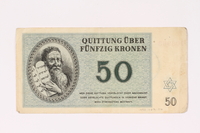
Theresienstadt ghetto-labor camp scrip, 50 kronen note
Object
Scrip, valued at 50 [funfzig] kronen, issued in Theresienstadt (Terezin) ghetto-labor camp after January 1, 1943. All currency was confiscated upon entry and replaced with scrip and ration coupons that could be exchanged only in the camp. The camp existed from November 24, 1941 to May 9, 1945, in a region of Czechoslovakia annexed by Germany, renamed the Protectorate of Bohemia and Moravia. Rose acquired the scrip from her brother-in-law Dr. Henri Brunswic, who lived in Paris, France. In November 1940, a year after the German occupation of Poland in September 1939, Raszka (Rose) Galek, her parents Moshe and Fela, and her younger sisters Deana and Sala were confined to the Warsaw ghetto. In April 1943, Raszka’s parents were shot as she watched and her sisters deported to a concentration camp and presumed killed. Raszka escaped and went into hiding. A resistance member, Jan Majewski, helped her obtain false papers as a Polish Catholic, Maria Kowalczyk. In June, she was sent as a forced laborer to a farm in Krummhardt, Germany. Raszka was liberated by US forces in April 1945. She moved to Stuttgart displaced persons camp and emigrated to the United States in 1947.

Theresienstadt ghetto-labor camp scrip, 100 kronen note
Object
Scrip, valued at 100 [hundert] kronen, issued in Theresienstadt (Terezin) ghetto-labor camp after January 1, 1943. All currency was confiscated upon entry and replaced with scrip and ration coupons that could be exchanged only in the camp. The camp existed from November 24, 1941 to May 9, 1945, in a region of Czechoslovakia annexed by Germany, renamed the Protectorate of Bohemia and Moravia. Rose acquired the scrip from her brother-in-law Dr. Henri Brunswic, who lived in Paris, France. In November 1940, a year after the German occupation of Poland in September 1939, Raszka (Rose) Galek, her parents Moshe and Fela, and her younger sisters Deana and Sala were confined to the Warsaw ghetto. In April 1943, Raszka’s parents were shot as she watched and her sisters deported to a concentration camp and presumed killed. Raszka escaped and went into hiding. A resistance member, Jan Majewski, helped her obtain false papers as a Polish Catholic, Maria Kowalczyk. In June, she was sent as a forced laborer to a farm in Krummhardt, Germany. Raszka was liberated by US forces in April 1945. She moved to Stuttgart displaced persons camp and emigrated to the United States in 1947.



